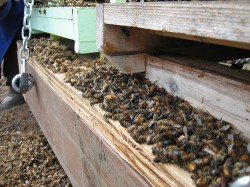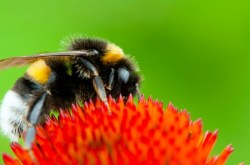
Dead bees at Hayes Valley farm in San Fransisco.
In late July 2010, up to 200,000 honeybees, kept in hives and dutifully producing honey at the Hayes Valley Farm in San Francisco, were massacred. That might seem like strong language, but how else might one describe the act of spraying pesticide directly into the entrances and ventilation holes of three beehives?
In June, two more hives were destroyed, this time at a different urban farm in San Francisco, Alemany Farm. Instead of a chemical killer, these 70,000 bees succumbed when broken concrete and tree limbs were hurled onto the hives from above, shattering the structures.
These two incidents may or may not have been linked, but they are related insofar as they are part of a troubling pattern of vandalism against urban apiaries. “The worst problem tends to be when, say, two 14-year-olds walk past some hives and say ‘I dare you,'” says Kim Flottum, a bee expert and publisher of Bee Culture magazine. “But,” he adds, “malicious vandalism is also increasing for various reasons. That’s the ugly side of human nature.”
It is ugly, yes. But it’s also detrimental to the urban beekeeping and urban farming movements and a growing concern among apiarists.
The vandalism extends to backyard beekeepers as well. Earlier this summer Michael Schwartz, a newbie beekeeper in Altadena, Calif., lost the roughly 10,000 bees inside three hives that he kept on the roof of his garage. He believes someone scaled his garage and sprayed something — a pesticide, maybe, or even something like oven cleaner — into the hives. “The bees would come out of the hive and then just fly in circles” until they stopped moving, he says.
It’s not just the monetary and emotional toll of the lost hives that bother Schwartz: “Someone put poison into the food supply for me and my family,” he says.
The bees at Hayes Valley Farm belonged to nonprofit group SF Bee-Cause, whose founders believe that the culprit was a local man who, just days before the bees were killed, complained to the farm workers that he and his family were allergic. “He said the hives were endangering him and his family and he didn’t want them there,” says Cameo Wood, who opened a beekeeping supply store in San Francisco in 2009 and co-founded Bee-Cause.
Karen Peteros, Wood’s co-founder, figures the honey and bees destroyed in 2010 represent more than $4,000 in lost revenue for Bee-Cause.
But vandalism isn’t the only thing causing concern among urban beekeepers. In New York City some beekeepers are starting to worry about the impact that very hot summers and limited foraging areas could have on the hives and the bees’ behavior.
In or out of the closet?

Photo by Jan S. / Shutterstock.
As urban populations grow in lockstep with interest in urban agriculture, conflicts over where and whether hives should be kept may continue to escalate.
“Historically, beekeepers want to stay under the radar,” says Peteros. “But being in the urban agriculture movement, we felt that having bees visible in an urban environment is also an important form of passive education. Even in dense urban places like San Francisco … if we are going to be successful in helping people grow their own food, we need pollinators.”
Bees are polarizing; people tend to love or hate them. As much as beekeeping advocates want to get everyone on the bee-loving bandwagon, the fact is that a certain segment of the population will always harbor intense fears of these insects. For the roughly 1 percent of the population that is allergic to bee venom — a number that Peteros and Flottum insist is much lower than the population assumes — that fear is well-founded.
This minority has good reason to be vocal about its concerns, and beekeepers need to respect them, says Flottum. “More people are killed by lightning every year than by bee stings. So the likelihood is small, but if you’re allergic you want [the likelihood] to be zero,” he adds.
Unlike Peteros, Flottum believes beekeepers should try not to draw attention to their hives. He suggests painting hives colors that match their surroundings and placing them in out-of-sight areas when possible. As long as the hives are well cared for and the beekeeper uses calm, or “lazy” bees, there is no reason the bees will bother anybody that does not bother them.
The best way to rise bees’ ire is to threaten their hives, so people who physically attack hives are the most likely to be attacked. Vandals also put people who happen to be nearby in danger.
How to bee a good neighbor
Here are Flottum’s tips for urban beekeepers who want to keep the peace:
- Talk to neighbors before bringing in the hives
- Educate them about the important role pollinators play in our food supply
- Register your bees with a state registry and keep good records
- Ensure that you always provide water for the bees, so they don’t go looking for other water sources
- Have an emergency plan if things go wrong and bees become aggressive
- Don’t work with your beehive when people are nearby



